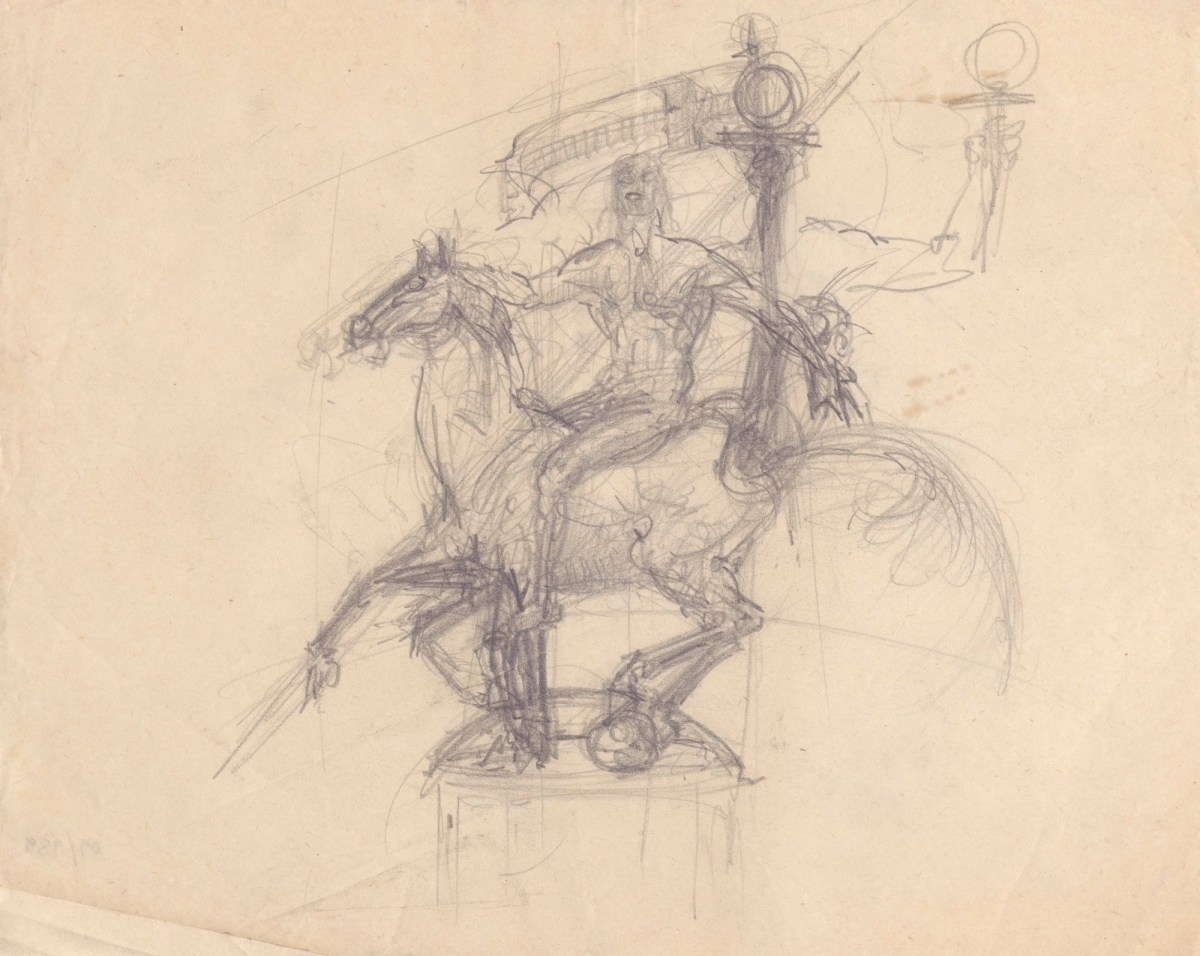
Maurice Lambert RA, Drawing for 'Kronos', c.1950s.
Pencil on paper. 200 mm x 250 mm. © Photo: Royal Academy of Arts, London.
This image is not available to download. To licence this image for commercial purposes, contact our Picture Library at picturelibrary@royalacademy.org.uk
Drawing for 'Kronos', c.1950s
Maurice Lambert RA (1901 - 1964)
RA Collection: Art
The drawings in this group all relate to Maurice Lambert's late sculpture 'Kronos' (c.1964; National Gallery of Australia, Canberra). Lambert began work on this design in the 1950s while he was Master of Sculpture at the Royal Academy and it was one of the last pieces that he produced. It was finished with the help of his assistant, Geoff Colley.
There is some debate over the meaning of the title and the iconography used by the artist. Lambert's spelling of the title, inscribed on some of these drawings, suggests that he intended it to be read as the name of the Titan Kronos (alternatively Cronus) who castrated his father, Uranus, and ate his own children. Vanessa Nicolson, in her monograph on Lambert, accepts this interpretation but notes the discrepancy between Lambert's boyish 'Kronos' and the Cronus of ancient myth, stating that: 'Lambert...presents the Hellenic ideal of male beauty: a classical profile and youthful, athletic body...this Cronus looks incapable of executing such bloodthirsty deeds. His pose is relaxed and open ... One of the horse's hoofs is attached to a second, smaller sphere, while the other is placed over a skull, symbol of death'. She interprets these features as references to Lambert's own life as he became terminally ill with cancer while working on this project.
However, as neither the youthful figure nor the iconographic motifs seem to correspond exactly with the myth of Cronus, it is possible that Lambert in fact intended this sculpture to represent Chronos (Time). This interpretation has been put forward by Steven Tonkin of the National Gallery of Australia, who suggests that Lambert chose to represent 'Time' as the mythological figure Bellerophon who tamed the winged horse Pegasus. Bellerophon was later thrown off his mount after angering the Gods by trying to ride to Mount Olympus. Tonkins interprets Bellerophon as a metaphor for the artist's life, stating that 'the sculpture seems to be principally concerned with the passing of time, the cycle of life, of birth, worldly success and death'.
This interpretation is very plausible but there remains some doubt. Tonkins suggests that the sculpture may simply have been wrongly titled after the artist's death but the spelling "Kronos" is clear from the inscriptions in Lambert's hand on some of the drawings in this group. Elements of the symbolism could equally apply to either the Titan Cronus or to the general concept of Time as represented by Bellerophon. Inscriptions on the drawings also reveal that the tiny figure held in the sling, for instance, is a foetus rather than a newborn baby. This could refer to Cronus who ate his own children as soon as they were born because it had been prophesied that he would be overthrown by one of his own offspring. Also, in the preparatory drawings, the horse is usually depicted without wings suggesting that this was a late addition to the design. This seems odd if the original intention was to represent Bellerophon.
Several drawings in this group show alternative designs for the sculpture. Kronos is variously depicted holding a laurel branch, a globe, a "solar disc", a lyre or a two-headed snake. Some drawings also show Kronos with a 'third eye' and the whole group set on top of a globe. However, these attributes only confuse the identification of the figure. The globe could relate to the story of Bellerophon who is also sometimes shown being presented with a laurel wreath but the laurel, lyre and snakes are more commonly symbols of Apollo.
It is possible that Lambert in fact merged the figures of Cronus and Khronos, adding his own esoteric references such as the 'third eye'. This is less anachronistic than it may seem as in Roman mythology Cronus is equated with Saturn who later came to be characterised as 'Father Time' so that the two very separate figures in ancient myth are conflated in modern symbolism.
References:
Vanessa Nicolson and Klio K. Panourgias, The Sculpture of Maurice Lambert, Henry Moore Foundation, Much Hadham, 2002, p. 95 and pp. 120-121, cat. no. 210
Steven Tonkin, Catalogue entry for 'Kronos' published online, National Gallery of Australia, Canberra, www.nga.gov.au/International/Catalogue
Object details
200 mm x 250 mm
Start exploring the RA Collection
- Explore art works, paint-smeared palettes, scribbled letters and more...
- Artists and architects have run the RA for 250 years.
Our Collection is a record of them.



